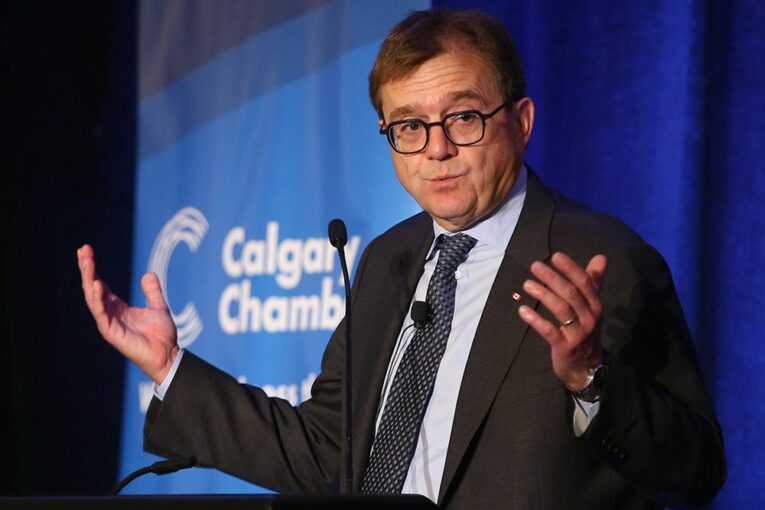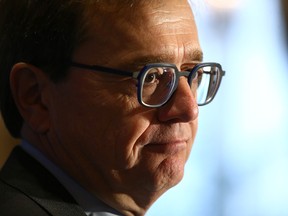
With Ottawa facing criticism for its emissions cap on the oil and gas sector and for sending mixed messages about LNG projects in the country, federal Natural Resources Minister Jonathan Wilkinson tried to disarm two political live wires in Calgary on Tuesday.
He insists Ottawa isn’t striving to shut in Canadian production and doesn’t oppose LNG developments.
Speaking at a Calgary Chamber of Commerce luncheon, Wilkinson said the ongoing development of a new emissions cap to be placed on the industry — the largest emitting sector in the country — needs to be done in consultation with producers and the province.
“It needs to be done in a manner that will drive emissions reductions,” he said of the cap.
“But also in a manner that ensures continuing economic opportunity and, in particular, in a manner that should not result in production being shut in as we approach 2030, when most forecasts indicate that demand for oil around the world will not be declining.”
Last week, the minister met with CEOs from a group of major oilsands producers, known as the Pathways Alliance, to ensure both sides are working on the issue together.
His remarks come as Ottawa has been pressing ahead with a promise made by Prime Minister Justin Trudeau during the 2021 federal election campaign to put a hard limit on oil and gas sector emissions.
The federal government wants the sector to reduce its greenhouse gas emissions by about 42 per cent by 2030. It’s an interim step as Canada strives to reach its net-zero target by 2050.
Major oilsands producers are already working together on a blueprint to get to net-zero, and plan on curbing emissions from operations by 22 megatonnes annually by 2030, which it says amounts to about a 27 per cent cut.
Yet, oilsands producers and industry groups have said the bigger federal target by the end of this decade isn’t feasible in such a short time frame.
And the UCP government has warned it will lead to a loss of expected production growth — and jobs — in the coming years.
Recommended from Editorial
-

Ottawa ready to work with Alberta’s next premier on climate goals
-

LNG Canada CEO says case for doubling export capacity ‘very strong’
-

Varcoe: Carbon capture odd couple — Kenney and Guilbeault share stance on oilsands and carbon capture
-

Canada’s new climate roadmap will require oil and gas sector to slash emissions 42% by 2030
Federal documents indicate the government is considering two options for the incoming cap: altering the existing carbon price and potentially setting a higher levy for the oil and gas sector, or implementing a cap-and-trade system.
The federal government is planning to increase the national price on carbon to $170 a tonne by the end of this decade, cut methane emissions in the sector by 75 per cent by 2030 and introduce a new clean fuel standard.
The federal cap is “too much, too fast,” Mark Cameron, vice-president of external relations for the Pathways Alliance, said in an interview Tuesday.
“If they were to use one of the two methods that they proposed, with a 42 per cent target, then it would require shutting in production,” Cameron said in an interview.
“It would be terrible for the Canadian economy. There are billions of dollars in royalties and revenues and income taxes going to both levels of government that will be impacted by that — and thousands of job losses.”
The two sides are talking, which is positive. However, Wilkinson wasn’t about to issue an ironclad guarantee that no output would be turned down because of the cap.
“It’s hard to give you an absolute guarantee,” he told reporters after the speech.
“But it should not result in the shutting in of production, that would not happen — absent a decline in the demand for oil around the world — (and) we don’t expect that to happen between now and 2030.”
So how can Ottawa meet its 42 per cent target and the industry’s objectives? That’s not clear, although the minister talked about looking for solutions with industry and the possibility of “compliance flexibility.”
It’s safe to say business leaders want to see the details.
“There’s a lot of tension around it,” said Mac Van Wielingen, founder and partner with ARC Financial Corp. and chair of the Business Council of Alberta.
“Quite frankly, there’s something about it that doesn’t feel collaborative. And that’s a problem and it creates tension. It feeds an already existing level of, quite frankly, distrust in Alberta and among investors.”
Aside from the contentious cap, Wilkinson also spoke Tuesday about LNG development in the country.

Canada has two projects moving ahead — including the massive LNG Canada facility on the Pacific Coast — although Ottawa has sometimes seemed ambivalent about future growth in the sector, particularly on the East Coast where gas could be exported to Europe.
On Tuesday, Wilkinson noted Europe has asked the federal government how Canada could potentially assist with LNG and hydrogen being exported from Eastern Canada. It has also established a working group with Germany and the European Union.
“I should note LNG from the West Coast of Canada, and in particular the LNG Canada facility . . . can also assist our European friends by providing enhanced supply to the global LNG market,” he added.
And yet, a clear signal isn’t always coming from Ottawa on this issue.
In August, Trudeau said there’s “never been a strong business case” for exporting LNG to Europe from the Atlantic coast. This view has frustrated industry proponents who see additional projects as a tangible way that Canadian natural gas can displace higher-emitting coal used in electrical generation in other countries.
“There are a lot of us who believe that LNG from . . . the B.C. coast is a major opportunity. But, of course, it needs to be done in a manner that actually is consistent with Canada’s own climate objectives,” Wilkinson said at the event.
“We haven’t given up on those (East Coast) projects, and we still are talking to the Germans . . . but at the end of the day, there has to be a value proposition that the customer is willing to purchase, and that’s the challenge.”
Chris Varcoe is a Calgary Herald columnist.
You can read more of the news on source
